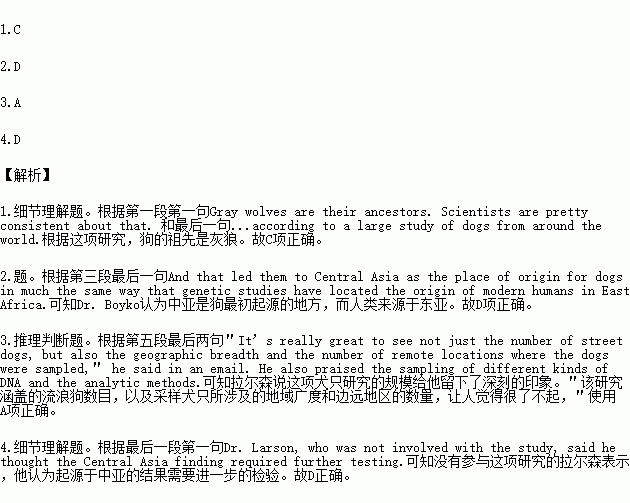题目内容
Passage 4(2016届江西省九校高三下学期联考)
体裁 | 话题 | 词数 | 难度 | 建议时间 |
说明文 | 狗的祖先 | 325 | ★★★☆☆ | 8分钟 |
Where do dogs come from?
Gray wolves are their ancestors. Scientists are pretty consistent about that. And researchers have suggested that dogs’ origins can date back to Europe, the Near East, Siberia and South China. Central Asia is the newest and best candidate, according to a large study of dogs from around the world.
Laura M. Shannon and Adam R. Boyko at Cornell University, and an international group of other scientists, studied not only purebred(纯种的) dogs, but also street or village dogs.
Dr. Shannon analyzed three different kinds of DNA, Dr. Boyko said, the first time this has been done for such a large and diverse group of dogs from 38 countries. And that led them to Central Asia as the place of origin for dogs in much the same way that genetic studies have located the origin of modern humans in East Africa.
The analysis, Dr. Boyko said, pointed to Central Asia, as the place where "all the dogs alive today" come from. The data did not allow precise dating of the origin, he said, but showed it occurred at least 15,000 years ago.
Greger Larson of Oxford University, who is leading a large international effort to analyze ancient DNA from fossilized bones, said he was impressed by the study. "It’s really great to see not just the number of street dogs, but also the geographic breadth and the number of remote locations where the dogs were sampled," he said in an email. He also praised the sampling of different kinds of DNA and the analytic methods.
Dr. Larson, who was not involved with the study, said he thought the Central Asia finding required further testing. He said he suspected that the origins of modern dogs were "extremely messy" and that no amount of sampling of living populations will be definitive. He said a combination of studies of modern and ancient DNA is necessary.
1.According to the research on a large number of dogs, we can know____________.
A. dogs mainly lived in Europe and the Far East
B. dogs would like to live in Central Asia
C. dogs’ ancestors come from gray wolves
D. the Near East has many gray wolves
2.What can we infer from what Dr. Boyko said?
A. There are three different kinds of DNA in dogs.
B. This is the second time they have done so many dogs.
C. They only do research on village dogs from many countries.
D. Modern humans are from East Africa while dogs come from Central Asia.
3.Greger Larson got a very deep impression of his study because he____________.
A. found the study based on many different dogs and the sample dogs’ remote locations
B. saw the number of street dogs from fossilized bones
C. watched the geographic breadth of the sampled dogs
D. praised his teammates for their hard work on the dogs
4.Who wasn’t engaged in the study of dogs’ origins?
A. Laura M. Shannon B. Adam R. Boyko
C. Shannon and Boyko D. Greger Larson
ssage3(2016·全国新课标I,C )
体裁 | 话题 | 词数 | 难度 | 建议时间 |
记叙文 | 莎士比亚的戏剧被翻译成几个国家的语言,并将在这些国家的大剧院上映 | 258 | ★★☆☆☆ | 5分钟 |
I am peter Hodes ,a volunteer stem courier. Since March 2012, I’ve done 89 trips of those , 51 have been abroad, I have 42 hours to carry stem cells(干细胞)in my little box because I’ve got two ice packs and that’s how long they last, in all, from the time the stem cells are harvested from a donor(捐献者) to the time they can be implanted in the patient, we’ve got 72 hours at most, So I am always conscious of time.
I had one trip last year where I was caught by a hurricane in America. I picked up the stem cells in Providence, Rhode Island, and was meant to fly to Washington then back to London. But when I arrived at the check-in desk at Providence, the lady on the desk said: "Well, I’m really sorry, I’ve got some bad news for you-there are no fights from Washington." So I took my box and put it on the desk and I said: "In this box are some stem cells that are urgently needed for a patient-please, please, you’ve got to get me back to the United Kingdom." She just dropped everything. She arranged for a flight on a small plane to be held for mere-routed(改道)me through Newark and got me back to the UK even earlier than originally scheduled.
For this courier job, you’re consciously aware than that box you’re got something that is potentially going to save somebody’s life.
1.Which of the following can replace the underlined word "courier" in Paragraph17
A. provider B. delivery man
C. collector D. medical doctor
2.Why does Peter have to complete his trip within 42hours?
A. He cannot stay away from his job too long.
B. The donor can only wait for that long.
C. The operation needs hat very much.
D. The ice won’t last any longer.
3.Which flight did the woman put Peter on first?
A. To London B. To Newark
C. To Providence D. To Washington

